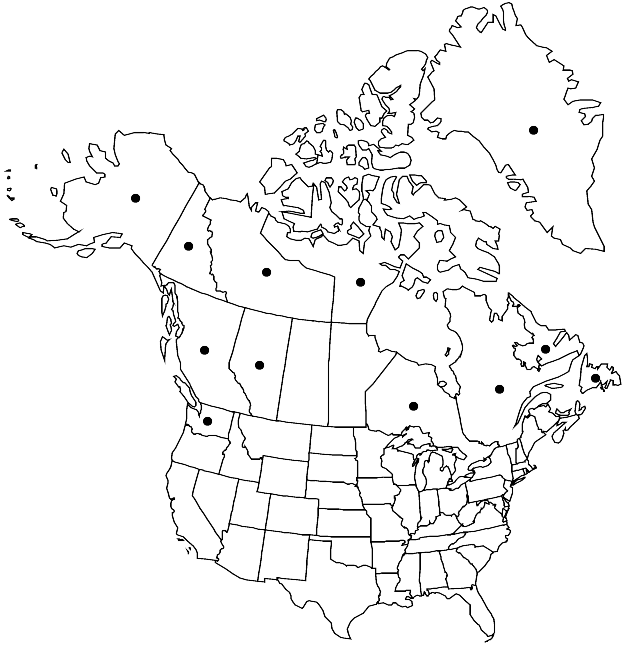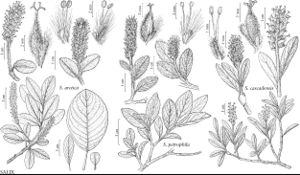Salix arctica
Fl. Ross. 1(2): 86. 1788.
Plants 0.03–0.25 m, not clonal or forming clones by layering. Stems erect, decumbent, or trailing; branches yellow-brown, gray-brown, or red-brown, (strongly glaucous or not, slightly glossy), glabrous; branchlets yellow-brown, red-brown, or violet, (strongly glaucous or not), usually densely villous or pilose (usually appearing unkempt), sometimes glabrous, (inner membranaceous bud-scale layer free, not separating from outer layer). Leaves: stipules absent, rudimentary, or foliaceous (0.2–1.5–10 mm); petiole 2–35 mm, (longer than subtended bud, puberulent or glabrous adaxially); largest medial blade hypostomatous or hemiamphistomatous, narrowly to broadly elliptic, subcircular, circular, oblanceolate, obovate, or broadly obovate, 10–85 × 5.5–60 mm, 1–3.6(–4.9) times as long as wide, base cuneate, convex, or rounded, margins slightly revolute or flat, entire, apex acuminate, acute, convex, or rounded, abaxial surface pilose or midrib sparsely short-silky, or apex long-silky bearded, hairs usually straight or wavy, adaxial slightly glossy or dull, glabrous, pilose or long-silky margin; proximal blade margins entire; juvenile blade glabrous or sparsely villous abaxially, hairs straight, oriented toward apex. Catkins: staminate 14–65 × 5–18 mm, flowering branchlet 2–36 mm; pistillate densely to moderately densely flowered (30+ flowers), slender, stout, or subglobose, 20–145 × 8–22 mm, flowering branchlet 2–40 mm; floral bract brown or black, 1.6–3.7 mm, margins sometimes sinuate, apex broadly rounded, convex, or retuse, entire, sinuate, or 2-fid, abaxially hairy, hairs straight. Staminate flowers: abaxial nectary (0–)0.3–0.8 mm, adaxial nectary narrowly oblong, oblong, or square, 0.5–1.2 mm, nectaries distinct; filaments distinct; anthers ellipsoid, 0.3–0.9 mm. Pistillate flowers: adaxial nectary oblong, ovate, or narrowly oblong, 0.4–1.8 mm, much longer than stipe; stipe 0.2–1.6 mm; ovary obclavate or pyriform, villous, beak abruptly to gradually tapering to or slightly bulged below styles; ovules 12–15 per ovary; styles (connate to distinct 1/2 their lengths), 0.6–2.2 mm; stigmas slenderly cylindrical, 0.35–0.56–0.88(–1.13) mm. Capsules 4–9 mm. 2n = 76, 114.
Phenology: Flowering early Jun-mid Aug.
Habitat: Arctic-alpine, wet to mesic or dry habitats, including hummocks in wet Sphagnum bogs and sedge meadows, polygonal tundra, solifluction slopes, snowbeds, margins of pools, beach ridges, shale and gypsum ridges, gneissic cliffs, colluvial slopes, talus slopes, glacial moraines, imperfectly drained calcareous silty till, muddy salt flats, frost-heaved clay polygons, dry calcareous gravel, coarse sandy soil
Elevation: 0-2000 m
Distribution

Greenland, Alta., B.C., Nfld. and Labr., N.W.T., Nunavut, Ont., Que., Yukon, Alaska, Wash., Eurasia (China, Chukotka, Novaya Zemlya, Russian Far East, arctic, e Siberia), Atlantic Islands (Iceland).
Discussion
Salix arctica is polymorphic and nomenclaturally confusing. E. Hultén (1967, 1971) recognized three subspecies: 1) subsp. arctica (circumpolar from Iceland and the Faeroe Islands across northern Russia, Alaska and Canada to Greenland, south to the Hudson Bay shores of Ontario and the Gaspe Peninsula); 2) subsp. crassijulis (a North Pacific race ranging from Kamchatka and the Russian Far East to the Aleutian Islands, south central and southeastern Alaska along the coast to northern Washington); and 3) subsp. torulosa (ranging from the mountains of central Asia to Kamchatka and the Bering Straits, the Brooks Range and the Rocky Mountains in Alaska, south in the cordillera to southern British Columbia and Alberta). While formal recognition of the three races is appealing, they are actually very difficult or impossible to separate morphologically and have strongly overlapping ranges. Some of the variability may be due to environmental modification (D. B. O. Savile 1964; G. W. Argus 1973; J. H. Soper and J. M. Powell 1985). On Attu Island, Alaska, there are plants to 2 m along with dwarf plants (C. Parker, pers. comm.). Their tall stature cannot be accounted for by habitat alone. The possibility that the complex morphological variability within S. arctica may be ecophenic or ecotypic deserves study.
T. E. Dawson (1987) showed that the pistillate-biased sex ratios in Salix arctica are environmentally controlled; pistillate plants are significantly over-represented in mesic-wet, more fertile sites with low soil temperature, whereas staminate plants are predominant in drier, less fertile sites.
The oldest reported age of Salix arctica is 236 years in East Greenland (H. M. Raup 1965) and 85 years on Ellesmere Island (D. B. O. Savile 1979b).
In northern Greenland, Salix arctica is one of the primary foods for musk ox, arctic hare, and collared lemming (D. R. Klein and C. Bay 1991).
Hybrids:
Salix arctica forms natural hybrids with S. arctophila, S. barclayi, S. fuscescens, S. glauca varieties, S. herbacea, S. ovalifolia, S. pedicellaris, S. phlebophylla, S. polaris, S. rotundifolia, and S. stolonifera.
Salix arctica × S. arctophila (S. ×hudsonensis C. K. Schneider) resembles S. arctophila in its trailing habit and toothed leaf margins, and S. arctica in its hairy leaves and petioles, particularly proximal leaves, and branchlets that are both hairy and glaucous. Ovaries have the flattened, refractive hairs of S. arctica, rather than the ribbonlike hairs of S. arctophila. Some plants have undeveloped ovaries, suggesting infertility. The plants are often sterile. Other putative hybrid specimens resemble S. arctica in having staminate flowers with abaxial and adaxial nectaries and anthers ca. 0.36 mm, and S. arctophila in having glabrous leaves and branchlets. N. Polunin (1940) described intermediates between these species from Burwell, Labrador, and Wakeham Bay, Quebec, but the available specimens were re-identified as either S. arctica or S. arctophila. Polunin (1943) wrote that in Greenland these two species do not “hybridize at all frequently” even where growing “side by side.”
Salix arctica × S. barclayi grows with both parents in tundra above the Tokositna Glacier, Alaska. It resembles S. barclayi in having buds with a distinct and separating inner membrane and stigmas broad and short, and S. arctica in its trailing habit (tundra shrub to 0.23 m) and in stipules absent. It is intermediate in having ovaries hairy only on beaks, and leaves with scattered marginal teeth. It also occurs in southeastern Alaska (G. W. Argus 1973).
Salix arctica × S. fuscescens has the growth form, habitat, and proximal leaves often with ferruginous hairs of S. fuscescens, but ovaries are densely hairy and long-styled as in S. arctica.
Salix arctica × S. glauca varieties: Hybrids are characterized by combinations of characteristics of S. arctica and S. glauca (G. W. Argus 1965, 1973; C. Bay 1992). They resemble S. arctica in its prostrate habit, glaucous branches and buds, sparse branchlet hairiness, dark-colored bracts with long, straight hairs, leaves with long, straight hairs on the abaxial surfaces projecting in a ‘beard’ at the apex, capsules reddish with long stigmas, and dark-colored anthers. They resemble S. glauca in its erect habit, leaves less oblanceolate and without the cuneate base of S. arctica, shorter petioles, bracts light-colored with shorter, wavy hairs, and divided styles. The presence of glaucous branches, as an indication of S. arctica, should be used with caution because S. pellita and S. planifolia also have glaucous branches, but these early flowering species may be phenologically isolated from S. glauca. On Baffin Island, Nunavut, the hybrid may be particularly difficult to recognize because of environmentally induced morphological convergence of S. arctica and S. glauca. On the Belcher Islands, on the east side of Hudson Bay, many plants have brownish to pinkish floral bracts with wavy or straight hairs, glabrate branches, and pilose branchlets, suggesting a hybrid swarm. Within the geographic overlap of S. arctica and S. glauca var. cordifolia, the name S. ×waghornei Rydberg can be applied to this hybrid (Argus 2003). See also A. K. Skvortsov (1971), Argus (1973), and Bay.
Salix arctica × S. herbacea occurring in northern Quebec, the eastern Canadian Arctic Archipelago, and eastern continental Nunavut resembles S. arctica in stems stouter, plants usually not rhizomatous, stipules often present, leaves sparsely glaucous abaxially, sometimes with long straight hairs, catkins more than 20-flowered and arising from lateral buds, and styles to 1.4 mm; and S. herbacea in plants sometimes rhizomatous, leaf margins crenulate, apex sometimes retuse, catkins few-flowered and sometimes arising from subterminal buds, ovaries glabrous, styles sometimes 0.2 mm. These hybrids set some seeds although the parental species have different chromosome numbers (tetraploid or hexaploid versus diploid, respectively). A variant of this hybrid with entire leaf margins was collected in eastern Greenland where both parents grow together. This hybrid resembles S. herbacea in leaf blades 0.5–1.1 times as long as wide with ciliate margins, floral bracts 0.9–1.2 mm, and stigmas 0.3 mm; and S. arctica in leaf margins entire and densely villous ovaries. It is intermediate between the two parents in leaf blades 11.5–14 mm, adaxial surfaces sparsely glaucous, floral bracts sparsely short-hairy, and styles 0.4–0.5 mm.
Salix arctica × S. ovalifolia: An intermediate specimen from Nuvagapak Point, Alaska, it resembles S. arctica in its growth form, leaf shape, and catkin size, and S. ovalifolia in ovaries sparsely hairy and glaucous and stigmas with a flat, non-papillate abaxial surface and pointed tip. It is very different from S. ovalifolia var. glacialis, which E. Hultén (1967) suggested may be the same hybrid.
Salix arctica × S. pedicellaris (S. ×hebecarpa (Fernald) Fernald, based on S. fuscescens var. hebecarpa Fernald), occurs in a raised sphagnum bog on Mt. Albert, Quebec. The population includes typical S. pedicellaris and the hybrids. Hybrids exhibit varying degrees of ovary and stipe hairiness, some juvenile leaf hairiness, and petioles that are deeply grooved and with margins that touch and overlap the groove. All of the specimens clearly indicate that S. pedicellaris is one parent, but the identity of S. arctica as the second parent is not established with certainty.
Salix arctica × S. phlebophylla is an apparently sterile hybrid that resembles S. phlebophylla in its general growth form and small, skeletonized leaves, and S. arctica in leaves thinly glaucous abaxially and ovaries hairy throughout. No seeds were set.
Salix arctica × S. polaris: Dwarf plants, presumed to be this hybrid, are characterized by being rhizomatous, as in S. polaris, but with leaves distinctly glaucous abaxially as in S. arctica. In general, the leaves and catkins are smaller than in typical S. arctica, and sometimes the styles also are shorter, but there is considerable variability. Ovaries are often sparsely hairy throughout, or glabrous at base or throughout except for the beak. The hybrids rarely form seed and may be infertile. Staminate plants may have anthers 0.9–1 mm, as in S. arctica, and leaves not glaucous abaxially, as in S. polaris. There is no single character that defines this hybrid and some plants from mixed populations appear to be intermediate. A specimen from Cornwallis Island, Northwest Territories, which was not rhizomatous but had relatively small, glaucous leaves and catkins with ovaries with patches of hairs especially on beaks, was presumed to be this hybrid, but it could simply be a dwarfed or abnormal specimen of S. arctica. In the Canadian Arctic Archipelago, this hybrid appears on Banks, Cornwallis, and Victoria islands. It is also known from Alaska, British Columbia, Northwest Territories, and Yukon.
Salix arctica × S. rotundifolia resembles S. rotundifolia except for its partially hairy ovaries and leaves glaucous abaxially.
Salix arctica × S. stolonifera occurs in swarms wherever the two parents grow together. The hybrids, and possible intergrades, have ovaries with bare patches or with hairs only on beaks.
Selected References
None.
